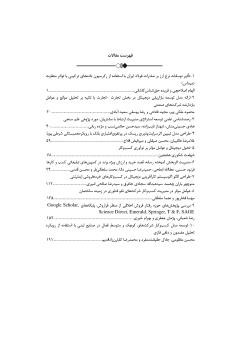طراحی مدل تبیین اثر سرایت پذیری ریسک در پرتفوی اعتباری بانک با رویکرد همبستگی شرطی پویا
محورهای موضوعی : مدیریت
غلامرضا طالبیان
1
![]() ,
محسن صیقلی
2
*
,
میرفیض فلاح
3
,
محسن صیقلی
2
*
,
میرفیض فلاح
3
1 - دانشجوی دکتری، گروه مدیریت مالی، واحد قزوین، دانشگاه آزاد اسلامی، قزوین، ایران
2 - استادیار، گروه مدیریت مالی، واحد قزوین، دانشگاه آزاد اسلامی، قزوین، ایران
3 - دانشیار، گروه مالی، واحد تهران مرکزی، دانشگاه آزاد اسلامی، تهران، ایران
کلید واژه: سرایت پذیری ریسک , پرتفوی اعتباری , همبستگی شرطی پویا , بانک.,
چکیده مقاله :
هدف از این مقاله "طراحی مدل تبیین اثر سرایت پذیری ریسک در پرتفوی اعتباری بانک با رویکرد همبستگی شرطی پویا" در بازه زمانی 1390\01\06 الی 1400\06\11 بطور روزانه می باشد. بدین منظور ابتدا ریسک هر یک از عقود با استفاده از مدل بهینه ARMA-GARCH بدست میآید و سپس مقادیر ارزش در معرض ریسک شرطی (CVaR) بعنوان عامل ریسک برای هر یک از عقود استخراج میگردد. مقادیر ریسک بدستآمده توسط مدلهای چند متغیره BEKK و DCC-GARCH مجدداَ مدلسازی میشوند تا بر مبنای نتایج بدستآمده آنها میزان سرایتپذیری تحلیل و به فرضیات تحقیق پاسخ داده شود.نتایج پژوهش نشان می دهد که سرایت نوسانات بین عقود مختلف در پرتفوی تسهیلاتی بانکها یک طرفه نیست.همچنین به طور قطعی نمی توان ادعا کرد که سرریز شوک ریسک از یک عقد به عقد دیگر متقارن می باشد.از این پژوهش، بهبود در عملکرد مدلهای پیشبینی و ایجاد استراتژیهای موثر برای مدیریت ریسک در بانکها قابل انتظار است.
This article introduces a designed model to elucidate the contagion effect of risk in the credit portfolio of a bank. The dynamic conditional correlation approach has been applied on a daily basis within the time span from March 26, 2011, to September 2, 2021, to model the dynamic patterns of changes in correlation among various types of risks. Initially, the risk for each contract is determined using the optimized ARMA-GARCH model. Subsequently, Conditional Value at Risk (CVaR) is extracted as the risk factor for each contract. The obtained risk values are further modeled using the multivariate BEKK and DCC-GARCH models to analyze the contagion levels based on their results and address the research hypotheses. The research results indicate that the contagion of oscillations among different contracts in the bank's loan portfolio is not unidirectional. Additionally, it cannot be definitively claimed that the spillover of risk shocks from one contract to another is symmetric. This study is anticipated to contribute to the enhancement of predictive model performance and the development of effective risk management strategies in banks.
1) براتی، لیلا، فلاح، میرفیض، غفاری، فرهاد، حیدرزاده هنزائی، علیرضا. (1402). برآورد ریسک فراگیر و سرایتپذیری آن در نظام مالی کشور با رویکرد مدل همبستگی شرطی پویا. مهندسی مالی و مدیریت اوراق بهادار، 14(56), 1-18.
2) باغبان، علی، غلامی جمکرانی، رضا، فلاح، میر فیض، کردلویی، حمیدرضا. (1401). سرایتپذیری و پویایی ریسک سیستمی تلاطم ارز واقعی و ارز مجازی در بازارهای مالی جهانی با رویکرد مدل BEKK. مهندسی مالی و مدیریت اوراق بهادار، 13(52), 179-162.
3) فلاح شمس، میرفیض، بنی شریف، عباس. (1400). سرایتپذیری ریسکهای مالی در بانکهای پذیرفتهشده در بورس اوراق بهادار تهران با استفاده از رهیافت MGARCH. تحقیقات مالی، 23(1), 87-107.
4) شفیعی، سمانه، خان محمدی، محمد حامد. (1401). فاصله تا نکول در بانکها با رویکرد حداکثر درستنمایی اطلاعات انتقالی. مهندسی مالی و مدیریت اوراق بهادار، 13(50), 154-175.
5) فلاحپور، سعید، & طادی، مسعود. (1395). پیشبینی ریسک نکول با استفاده از مدل ساختاری توسعهیافته در بورس اوراق بهادار تهران. مهندسی مالی و مدیریت اوراق بهادار، 7(28), 1-21.
6) Biggiero, L. (2020). Intra-Portfolio Systemic Contagion. Regulation of Financial Institutions eJournal.
7) Budiandru, B. (2021). Default Risk on Islamic Banking in Indonesia. Journal of Economics, Business, & Accountancy Ventura.
8) Ding, L. & Zhang, Y. (2022). Risk contagion and bank stability: the role of credit risk and liquidity risk. Journal of Risk Model Validation, 18(4).
9) Indriasari, E. Prabowo, H. Gaol, F. L. & Purwandari, B. (2022). Digital Banking: Challenges, Emerging Technology Trends, and Future Research Agenda. International Journal of E-Business Research (IJEBR), 18(1), 1-20.
10) Lestari, W. Pertiwi, W. & Yuliawati, J. (2023). The Role Of Credit Training To Improve Employee Performance Of Bpr Wiawa Mukti Jabar Bekasi. Edutran Business and Management, 1(1), 77-83.
11) Maddileti, K. & Kumar, B.R. (2019). An Empirical Study on Industrial Credit Portfolio of Banking Sector in India - During Post Reforms Era. International Journal of Management Studies.
12) Mihail-Dragos, B. & Peter, B. (2010). Possibilities of Improving the Methods and Techniques Used In the Surveillance of Credit Risk Management. Annals of the University of Oradea, Economic Science Series, 19(2).
13) Sayitkulov, J. I. (2023). DIGITAL FINANCIAL SERVICES IN THE BANKING SYSTEM: PROGRESS AND MEETING UPCOMING CHALLENGES. Frontline Marketing, Management and Economics Journal, 3(10), 25-37.
14) Vijayashree, M. C. (2022). Recent Trends, Major Opportunities and Challenges of Digital Banking in Indian Context. International Journal of Research Publication and Reviews, 3(10), 269-276.
15) Wang, D. van Lelyveld, I. & Schaumburg, J. (2018). Do Information Contagion and Business Model Similarities Explain Bank Credit Risk Commonalities? PSN: Financial Institutions (Topic).
16) Magnis, C. & Iatridis, G. E. (2019, January). The Relation between Earnings Quality and Default Risk in the Banking Sector. Evidence from 6 Countries. In INTERNATIONAL CONFERENCE ON BUSINESS & ECONOMICS OF THE HELLENIC OPEN UNIVERSITY 2019.
17) Rösch, D. (2004). Default Risk in Banking Portfolios-Concepts for Modeling, Estimation and Forecasting (Doctoral dissertation, Universität Regensburg).

